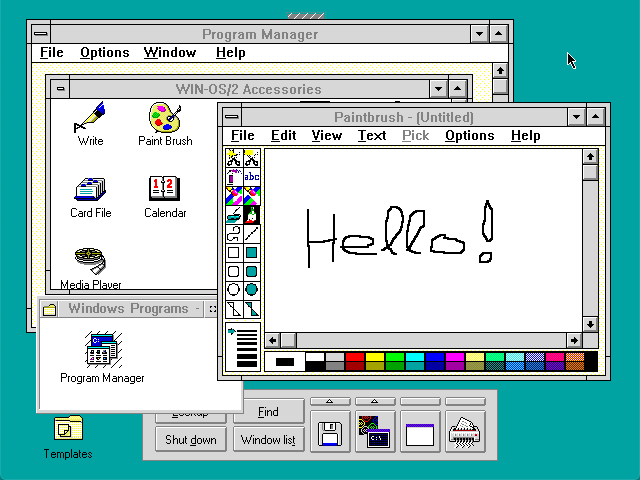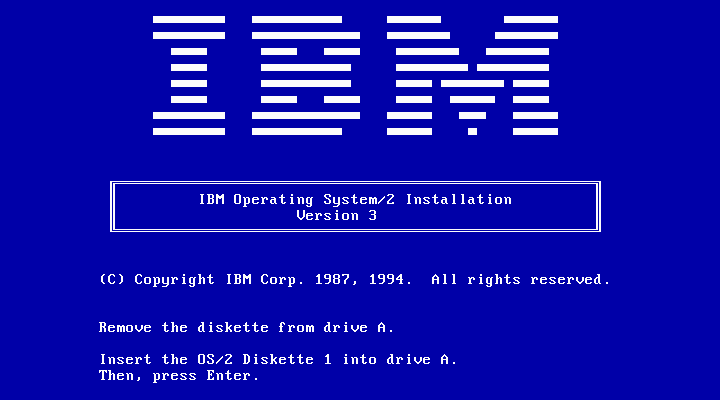OS/2 1.1; OS/2 1.3; OS/2 2.1; Warp 3; Warp 4; Warp 4.5; If you use one of those, almost nothing in this doc is relevant. If you'd prefer to experience the joy of installing and configuring, or are working on a real-steel machine, press on. Each version of OS/2 is a slightly different experience and you should try each of them if. We can download an installation ISO image for OS/2 Warp 4 from WinWorld, available here. The image I downloaded is IBM OS 2 Warp 4. 52 ( 4.52.14.086 W 4 ), the last retail image of OS/2 Warp 4 with all previous system updates, similar to 'Windows XP with SP3'. Download VirtualBox and install it, if you do not have it yet. Download and extract the OS/2 Warp 4.0 CD Version. Once extracted, there should be four files you need: Installation.img; Disk01.img; Disk02.img; IBMOS2Warp4.iso; To set up VirtualBox, do the following: Create a new Machine; Enter the name for the Machine as desired; Set Type to. Apr 03, 2004 1994 Oct. OS/2 Warp 3.0 networkable, P2P 1996 - OS/2 Warp Server Combination of Warp 3.0 aIBM's LAN Server 4.0, server services, remote login 1996 Oct. OS/2 Warp 4.0 (merlin) Integration of the pentium III instructions, improved Plug and Play and multimedia, includes Java and VoiceType technology, universally network client. In this video, I install IBM's OS/2 Warp 4.52 in Oracles VirtualBox (with hints on how to install it on a real vintage PC).Jump to installation: https://yout.
- OS/2 (OS) | VETUSWARE.COM - The Biggest Free Abandonware ...
- See All Results For This Question
- OS/2 Operating System
- OS/2 – ArchiveOS
- Os 2f2 Warp 3 Iso Download Free
Comments
- Most older computers can't boot from usb, so you are going to have to use a cd , A bootloader does exist that allows you to boot from a usb if the bios doesn't allow it , but it is a floppy image , But the way that a cd boots is of course with a floppy image , there is a hidden folder in a bootable cd that had a bootable floppy image , which is the way that a cd can boot. Its this bootloader called plop [urlhttps://www.plop.at/en/bootmanagers.html][/url] , I do not remember if it has a cd iso with the bootloader , but you can make one yourself , using any program that allows you to make cd images , you can make a bootable cd image using the floppy image. I believe plop will boot a usb floppy not totally sure , but I know it will boot a usb flash drive.
- If the floppy images are 'normal' 1.44 MB and the USB floppy drive is supported in the firmware, then you can probably boot from it.
- The ThinkPad T22 can boot from USB devices. Just attach the USB floppy drive and hit F12 at BIOS screen.
- well ive got it to boot to the usb floppy disk drive and it boots but when I insert disk 02 it gives me an error message that it is unable to configure my hardisk or floppy disk drive ive done some research and apparently you need a real drive and i prefer not to salvage a docking station and diskette drive to install OS2
- how do install os/2 with out a diskette drive all i have is a usb diskette drive and when i install it it give me an error message saying os/2 is unable to configure the hardisk or floppy drive please reboot your computer by the use of control alt delete or by pressing the reset switch. my specs are as shown i have an ibm thinkpad t22 900mhz pentuim 3 ,cdrw drive , a 6.5 gig hardisk i use install os/2 and last is an overkill of 256 mb ram and 8 megs of vram
- Um, OS/2 won't install on a system with more than 64 MB of RAM and I think a 6.5 GB hard drive requires special install disks. http://www.warpdoctor.org/downloads.html has install disks that allow Warp to be placed on a Thinkpad with larger than 4 GB hard disk.
USB floppy drives won't handle the IBM XDF format used on most OS/2 floppies. After the install starts, hope the CD drive works.
Note that the system you are installing on is capable enough to run Warp in a virtual machine which would save you a lot of grief trying to run an OS with drivers more than 5 years older than the hardware. Um... What version?
I use warp 4.52 just fine on a near-stock IBM ThinkPad type 2885 (x31) ('60'GB hdd)
IT HAS 512 OF RAM!
Frankly, OS/2 is a monster on that thing
(looks over at os/2 with 6 WIN-OS/2 sessions, 8 apps, and 3 explorer windows open)Years ago I had rigged a CD-ROM with MS-DOS that would boot up, I'd format the disk with 2 partitions, and install MS-DOS into the first partition, boot up DOS, and then use the restore command to restore my OS/2 install onto DOS. Naturally there is no extended attributes, so to cheat I had another backup of my OS/2 install done in OS/2 on the 2nd partition, then use the dual boot feature of OS/2 to boot up to cmd.exe
Now in a minimal OS/2 boot, I could then restore my full OS/2 install, reboot and I had restored OS/2 with all the EA's onto a fat disk.
the same methodology works for OS/2 1.21 as well, Just a shame there is no 'convert' program to convert FAT to HPFS.
OS/2 (OS) | VETUSWARE.COM - The Biggest Free Abandonware ...
Preamble
Creating the correct installation diskettes to install OS/2 unto unusual hardware hasalways been the trickiest part of the entire process. This is probably the most involvedsingle step in this guide. However, anyone who can edit a DOS config.sys file and knowwhat they're doing can cope with this.
The procedure is as follows:
IBM packs the diskette files into .DSK files on the OS/2 CD. You'll need to use XDFCOPYto unpack these files back onto diskettes. XDFCOPY.EXE lives in DISKIMG on the CD - it'sa good idea to temporarily add this directory to your operating system's command path.When I talk about creating a diskette from, for example, DISK1.DSK, I mean you should typein the command


XDFCOPY DISK1.DSK A:
XDFCOPY has two extra parameters:
- /Y - do not prompt the user to press a key before copying to the diskette
- /NV - do not verify the diskette once written
I tend to use both parameters to speed up the process. If you have trouble with aparticular diskette during the installation, remake it and omit the /NV parameter so thatit gets verified during creation.

Create the three standard installation diskettes from the CD
From the DISKIMGSOS235 directory on the OS/2 CD, create the first three diskettesfrom DISK0.DSK, DISK1.DSK, and DISK2.DSK.
Next, you might want to create some free space on Disk 1 so that anyparallel port storage device drivers you may need can be placed there. Any of thefollowing files could be deleted to free up space:
Drivers | Needed for |
| AHA*.ADD | Adaptec SCSI controllers |
| AHA*SNP | |
| AIC*.ADD | |
| AIC*.SNP | |
| BTSCSI.ADD | More SCSI support |
| BTSCIS.SNP | |
| CHINCDS1.FLT | Chinon CD-ROM |
| DAC960.ADD | More SCSI support |
| DAC960.SNP | |
| DPT20XX.ADD | |
| DPT20XX.SNP | |
| FD*.ADD | Future Domain SCSI controllers |
| FD*.SNP | |
| HITCDS1.FLT | Hitachi CD-ROM |
| IBMIDECD.FLT | IDE CD-ROM |
| IPSRAID.ADD | RAID controller |
| IPSRAID.SNP | |
| LMS206.ADD | Philips CD-ROM |
| MITFX001.ADD | Mitsumi CD-ROM |
| MITFX001.SNP | |
| NECCDS1.FLT | NEC CD-ROM |
| NETDET*.SNP | Network adapter detection |
| SBCD2.ADD | CD attached to SoundBlaster card |
| SBCD2.SNP | |
| SONY31A.ADD | Sony CD-ROM |
| SONY31A.SNP | |
| SONY535.ADD | |
| SONYCDS1.FLT | |
| TMV1SCSI.ADD | More SCSI support |
| TOSHCDS1.FLT | Toshiba CD-ROM |
You will also want to REM out the lines in CONFIG.SYS which refer to these, and place asemi-colon in front of lines in SNOOP.LST which refer to the .SNP files above.
See All Results For This Question

Ensure the correct ordering of the PCMCIA drive and the flash ROM drive
First, make sure you know the PC110 drive configuration is correctly configured. Istrongly recommend you install with your PCMCIA drive as the primary IDE channel device,and your Flash drive as the secondary channel device.
To do this, you should follow these steps:
OS/2 Operating System
- Ensure that all drives you want to be visible are included in your startup sequence, and that the ordering will boot the desired partition. I chose FDD-1, PCMCIA, HDD-1 to boot from floppy, then PCMCIA drive, then the 4MB Flash drive. See BIOS support for PCMCIA devices if you need more information on this part.
- Ensure that your IDE controllers are recognised in the default order; you do this by issuing the PS2 command PS2 _@ATA SECONDARY whilst booted into DOS. See the section on PS2 commands for more detail on this command. This ensures that both the PCMCIA drive and the Flash drive can be seen.
Once the drive controllers are in this configuration, and so we know they are visibleand using certain resources, the final preparation is for the order in which the OS/2 IDEdriver loads support for these channels. It makes sense for the PCMCIA drive to be seen onthe primary IDE channel, even though we have set it above to use the secondary channelresources. To accomplish this, we tell the OS/2 IDE driver to swap the channel allocationsfor the given devices, by altering one line in the CONFIG.SYS to read:
BASEDEV=IBM1S506.ADD /A:0 /P:170 /IRQ:15 /A:1 /P:1F0 /IRQ:14
The PCMCIA hard drive (assuming it has a single primary partition) should be seen asC:, and the flash ROM should be D:.
Boot the disks, then proceed to partition and install
When you boot from Disk 0, you'll see a white rectangle and 'OS/2' displayed in the topleft of the screen - hit the following keys to gain extra control over the boot sequence:
- <ALT>+<F1> - Bring up the Recovery Choices menu, with options to boot to a command prompt, reset to VGA, and others.
- <ALT>+<F2> - Continues to boot but displays the filename of each driver as it's loaded. Good for diagnosing boot hangs.
My installation diskettes
If you want to check my installation disk changes, click below for more details:
OS/2 – ArchiveOS
Back to OS/2 installation guide